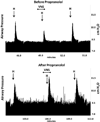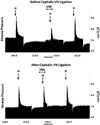Low voltage vagal nerve stimulation reduces bronchoconstriction in guinea pigs through catecholamine release
- PMID: 22551486
- PMCID: PMC3710689
- DOI: 10.1111/j.1525-1403.2012.00454.x
Low voltage vagal nerve stimulation reduces bronchoconstriction in guinea pigs through catecholamine release
Abstract
Objective: Electrical stimulation of the vagus nerve at relatively high voltages (e.g., >10 V) can induce bronchoconstriction. However, low voltage (≤2 V) vagus nerve stimulation (VNS) can attenuate histamine-invoked bronchoconstriction. Here, we identify the mechanism for this inhibition.
Methods: In urethanea-nesthetized guinea pigs, bipolar electrodes were attached to both vagus nerves and changes in pulmonary inflation pressure were recorded in response to i.v. histamine and during VNS. The attenuation of the histamine response by low-voltage VNS was then examined in the presence of pharmacologic inhibitors or nerve ligation.
Results: Low-voltage VNS attenuated histamine-induced bronchoconstriction (4.4 ± 0.3 vs. 3.2 ± 0.2 cm H(2) O, p < 0.01) and remained effective following administration of a nitric oxide synthase inhibitor, NG-nitro-L-arginine methyl ester, and after sympathetic nerve depletion with guanethidine, but not after the β-adrenoceptor antagonist propranolol. Nerve ligation caudal to the electrodes did not block the inhibition but cephalic nerve ligation did. Low-voltage VNS increased circulating epinephrine and norepinephrine without but not with cephalic nerve ligation.
Conclusion: These results indicate that low-voltage VNS attenuates histamine-induced bronchoconstriction via activation of afferent nerves, resulting in a systemic increase in catecholamines likely arising from the adrenal medulla.
© 2012 International Neuromodulation Society.
Conflict of interest statement
Figures






Similar articles
-
Regulation of NANC neural bronchoconstriction in vivo in the guinea-pig: involvement of nitric oxide, vasoactive intestinal peptide and soluble guanylyl cyclase.Br J Pharmacol. 1993 Jan;108(1):228-35. doi: 10.1111/j.1476-5381.1993.tb13467.x. Br J Pharmacol. 1993. PMID: 7679032 Free PMC article.
-
Characteristics of vagal reflex-mediated tracheal response induced by bronchoconstriction in guinea pigs.Eur J Pharmacol. 1996 Apr 29;302(1-3):89-97. doi: 10.1016/0014-2999(96)00017-9. Eur J Pharmacol. 1996. PMID: 8790996
-
Beta 2- but not beta 1-adrenoceptors mediate the adrenergic component of reflex tracheal dilatation during bronchoconstriction in guinea pigs in vivo.Res Commun Mol Pathol Pharmacol. 1996 Sep;93(3):301-18. Res Commun Mol Pathol Pharmacol. 1996. PMID: 8896042
-
Cigarette smoke-inhibition of neurogenic bronchoconstriction in guinea-pigs in vivo: involvement of exogenous and endogenous nitric oxide.Br J Pharmacol. 1997 Oct;122(4):779-85. doi: 10.1038/sj.bjp.0701440. Br J Pharmacol. 1997. PMID: 9375977 Free PMC article.
-
A Respiratory Marker Derived From Left Vagus Nerve Signals Recorded With Implantable Cuff Electrodes.Neuromodulation. 2018 Apr;21(3):269-275. doi: 10.1111/ner.12630. Epub 2017 Jul 11. Neuromodulation. 2018. PMID: 28699322 Review.
Cited by
-
HMGB1: A Potential Target of Nervus Vagus Stimulation in Pediatric SARS-CoV-2-Induced ALI/ARDS.Front Pediatr. 2022 May 11;10:884539. doi: 10.3389/fped.2022.884539. eCollection 2022. Front Pediatr. 2022. PMID: 35633962 Free PMC article.
-
Selective Neuromodulation of the Vagus Nerve.Front Neurosci. 2021 May 24;15:685872. doi: 10.3389/fnins.2021.685872. eCollection 2021. Front Neurosci. 2021. PMID: 34108861 Free PMC article. Review.
-
Current Approaches to Neuromodulation in Primary Headaches: Focus on Vagal Nerve and Sphenopalatine Ganglion Stimulation.Curr Pain Headache Rep. 2016 Jul;20(7):47. doi: 10.1007/s11916-016-0577-5. Curr Pain Headache Rep. 2016. PMID: 27278441 Free PMC article. Review.
-
Chronic migraine headache prevention with noninvasive vagus nerve stimulation: The EVENT study.Neurology. 2016 Aug 2;87(5):529-38. doi: 10.1212/WNL.0000000000002918. Epub 2016 Jul 13. Neurology. 2016. PMID: 27412146 Free PMC article. Clinical Trial.
-
Neuromodulation Strategies to Reduce Inflammation and Improve Lung Complications in COVID-19 Patients.Front Neurol. 2022 Jul 14;13:897124. doi: 10.3389/fneur.2022.897124. eCollection 2022. Front Neurol. 2022. PMID: 35911909 Free PMC article. Review.
References
-
- Trends in asthma morbidity and mortality. New York, NY: American Lung Association; 2011. 4-1-2011. http://lungusa.org/finding-cures/our-research/trend-reports/asthma-trend....
-
- Sepulveda P, Bohill G, Hoffmann T. Treatment of asthmatic bronchoconstriction by percutaneous low voltage vagal nerve stimulation: case report. Internet J Asthma Allergy Immunol. 2009;7:2.
-
- Miner J, Lewis L, Mosnaim G, Varon J, Theodoro D, Hoffmann T. Percutaneous vagal nerve stimulation for the treatment of acute asthma exacerbations. Acad Emerg Med. 2012;19:421–429. - PubMed
-
- Hoffmann TJ, Mendez S, Staats P, Emala CW, Guo P. Inhibition of histamine-induced bronchoconstriction in guinea pig and swine by pulsed electrical vagus nerve stimulation. Neuromodulation. 2009;12:261–269. - PubMed
-
- Jooste E, Zhang Y, Emala CW. Neuromuscular blocking agents’ differential bron-choconstrictive potential in guinea pig airways. Anesthesiology. 2007;106:763–772. - PubMed
Publication types
MeSH terms
Substances
Grants and funding
LinkOut - more resources
Full Text Sources
Other Literature Sources

